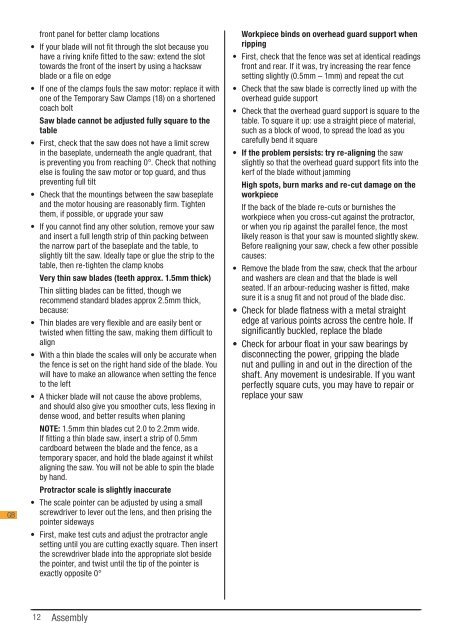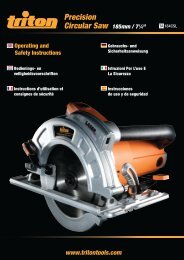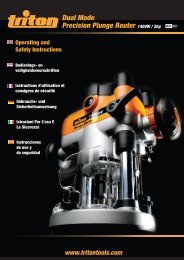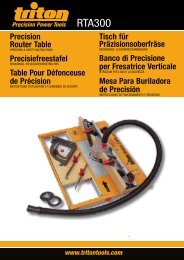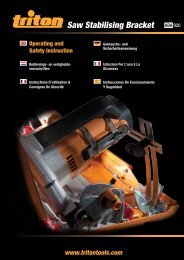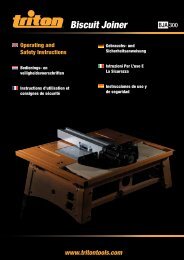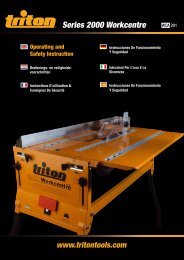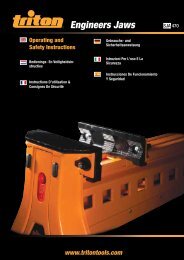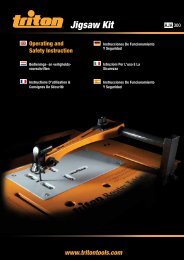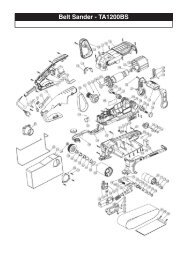Manual de instrucciones - Triton Tools
Manual de instrucciones - Triton Tools
Manual de instrucciones - Triton Tools
You also want an ePaper? Increase the reach of your titles
YUMPU automatically turns print PDFs into web optimized ePapers that Google loves.
GB<br />
front panel for better clamp locations<br />
• If your bla<strong>de</strong> will not fit through the slot because you<br />
have a riving knife fitted to the saw: extend the slot<br />
towards the front of the insert by using a hacksaw<br />
bla<strong>de</strong> or a file on edge<br />
• If one of the clamps fouls the saw motor: replace it with<br />
one of the Temporary Saw Clamps (18) on a shortened<br />
coach bolt<br />
Saw bla<strong>de</strong> cannot be adjusted fully square to the<br />
table<br />
• First, check that the saw does not have a limit screw<br />
in the baseplate, un<strong>de</strong>rneath the angle quadrant, that<br />
is preventing you from reaching 0°. Check that nothing<br />
else is fouling the saw motor or top guard, and thus<br />
preventing full tilt<br />
• Check that the mountings between the saw baseplate<br />
and the motor housing are reasonably firm. Tighten<br />
them, if possible, or upgra<strong>de</strong> your saw<br />
• If you cannot find any other solution, remove your saw<br />
and insert a full length strip of thin packing between<br />
the narrow part of the baseplate and the table, to<br />
slightly tilt the saw. I<strong>de</strong>ally tape or glue the strip to the<br />
table, then re-tighten the clamp knobs<br />
Very thin saw bla<strong>de</strong>s (teeth approx. 1.5mm thick)<br />
Thin slitting bla<strong>de</strong>s can be fitted, though we<br />
recommend standard bla<strong>de</strong>s approx 2.5mm thick,<br />
because:<br />
• Thin bla<strong>de</strong>s are very flexible and are easily bent or<br />
twisted when fitting the saw, making them difficult to<br />
align<br />
• With a thin bla<strong>de</strong> the scales will only be accurate when<br />
the fence is set on the right hand si<strong>de</strong> of the bla<strong>de</strong>. You<br />
will have to make an allowance when setting the fence<br />
to the left<br />
• A thicker bla<strong>de</strong> will not cause the above problems,<br />
and should also give you smoother cuts, less flexing in<br />
<strong>de</strong>nse wood, and better results when planing<br />
NOTE: 1.5mm thin bla<strong>de</strong>s cut 2.0 to 2.2mm wi<strong>de</strong>.<br />
If fitting a thin bla<strong>de</strong> saw, insert a strip of 0.5mm<br />
cardboard between the bla<strong>de</strong> and the fence, as a<br />
temporary spacer, and hold the bla<strong>de</strong> against it whilst<br />
aligning the saw. You will not be able to spin the bla<strong>de</strong><br />
by hand.<br />
Protractor scale is slightly inaccurate<br />
• The scale pointer can be adjusted by using a small<br />
screwdriver to lever out the lens, and then prising the<br />
pointer si<strong>de</strong>ways<br />
• First, make test cuts and adjust the protractor angle<br />
setting until you are cutting exactly square. Then insert<br />
the screwdriver bla<strong>de</strong> into the appropriate slot besi<strong>de</strong><br />
the pointer, and twist until the tip of the pointer is<br />
exactly opposite 0°<br />
Workpiece binds on overhead guard support when<br />
ripping<br />
• First, check that the fence was set at i<strong>de</strong>ntical readings<br />
front and rear. If it was, try increasing the rear fence<br />
setting slightly (0.5mm – 1mm) and repeat the cut<br />
• Check that the saw bla<strong>de</strong> is correctly lined up with the<br />
overhead gui<strong>de</strong> support<br />
• Check that the overhead guard support is square to the<br />
table. To square it up: use a straight piece of material,<br />
such as a block of wood, to spread the load as you<br />
carefully bend it square<br />
• If the problem persists: try re-aligning the saw<br />
slightly so that the overhead guard support fits into the<br />
kerf of the bla<strong>de</strong> without jamming<br />
High spots, burn marks and re-cut damage on the<br />
workpiece<br />
If the back of the bla<strong>de</strong> re-cuts or burnishes the<br />
workpiece when you cross-cut against the protractor,<br />
or when you rip against the parallel fence, the most<br />
likely reason is that your saw is mounted slightly skew.<br />
Before realigning your saw, check a few other possible<br />
causes:<br />
• Remove the bla<strong>de</strong> from the saw, check that the arbour<br />
and washers are clean and that the bla<strong>de</strong> is well<br />
seated. If an arbour-reducing washer is fitted, make<br />
sure it is a snug fit and not proud of the bla<strong>de</strong> disc.<br />
• Check for bla<strong>de</strong> flatness with a metal straight<br />
edge at various points across the centre hole. If<br />
significantly buckled, replace the bla<strong>de</strong><br />
• Check for arbour float in your saw bearings by<br />
disconnecting the power, gripping the bla<strong>de</strong><br />
nut and pulling in and out in the direction of the<br />
shaft. Any movement is un<strong>de</strong>sirable. If you want<br />
perfectly square cuts, you may have to repair or<br />
replace your saw<br />
12<br />
Assembly


